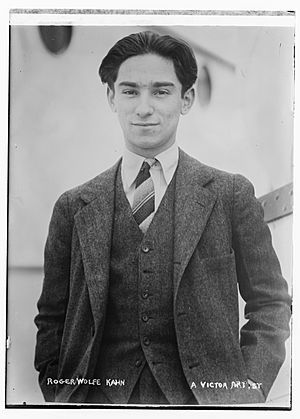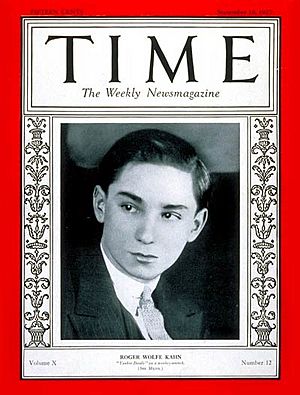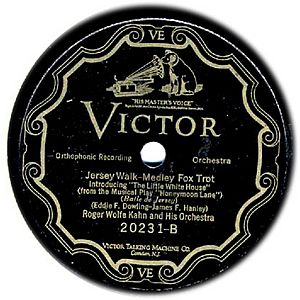Roger Wolfe Kahn facts for kids
Quick facts for kids
Roger Wolfe Kahn
|
|
|---|---|

Kahn circa 1925
|
|
| Background information | |
| Birth name | Roger Wolff Kahn |
| Born | October 19, 1907 Morristown, New Jersey, U.S. |
| Died | July 12, 1962 (aged 54) Columbia Presbyterian Medical Center, Manhattan, New York City, U.S. |
| Genres | Jazz, popular |
| Occupation(s) | Bandleader, composer, test pilot, aviator |
| Instruments | Saxophone, violin, drums, piano, etc. |
| Years active | 1924–1934 |
Roger Wolfe Kahn (born October 19, 1907, died July 12, 1962) was a talented American musician. He was a jazz and popular music artist, a composer, and led his own band, "Roger Wolfe Kahn and His Orchestra." Besides music, he was also a skilled pilot.
Contents
Early Life and Musical Talent
Roger Wolfe Kahn was born in Morristown, New Jersey. His family was very wealthy, and his father, Otto Hermann Kahn, was a famous banker who supported the arts. Both Roger and his father appeared on the cover of Time magazine, which was a unique achievement. Roger was only 19 when he was featured in September 1927.
Time magazine once wrote about Roger: "It is strange that Otto Hermann Kahn, a supporter of high art, has a son who plays the saxophone, banjo, clarinet, and jazz violin." They also noted that Roger, at just 18, was already a "truly outstanding jazzer." His ten orchestras, including one he led, earned him a lot of money.
Roger started learning the violin at age six. He reportedly learned to play 18 different musical instruments. By age 16, he was leading his own orchestra. He bought a ukulele at age ten and taught himself to play. This sparked his interest in many other instruments like the violin, piano, banjo, and saxophone. He taught himself to play every instrument in his band.
Instead of going to college, Roger started his own booking agency. He formed a band that played at the Knickerbocker Grill in New York. By the time he was 19, he had 11 orchestras playing in hotels and resorts. His success helped him follow his other passions: composing music and flying airplanes.
Music Career Highlights
In 1925, Roger Kahn appeared in a short film using an early sound-on-film process called Phonofilm. He hired many famous jazz musicians and singers for his band. Some of these included Tommy Dorsey, Joe Venuti, Artie Shaw, and Gene Krupa. His band was sometimes called Roger Wolfe Kahn and His Hotel Biltmore Orchestra.
In 1925, Joe Venuti joined Kahn's Orchestra while they were playing at the New York Biltmore Hotel. Kahn and his orchestra recorded songs for major labels like Victor Records, Brunswick Records, and Columbia Records.
In February 1926, Kahn's recording of I'm Sitting On Top Of The World became a hit, reaching #9 on the charts. Variety magazine reported that Kahn's orchestra was very popular and earned a lot of money for their performances.
Roger Kahn also owned several popular nightclubs in New York. One of his clubs, Le Perroquet de Paris, opened in November 1926. He spent a lot of money decorating it, even installing a mirrored dance floor and aquariums under the tables. He would give expensive perfumes to female guests, just like clubs in Paris. Variety magazine called it "the last gasp in smart night clubs."
In 1927, Kahn produced two short films called Night Club using Vitaphone technology. These films were an early attempt at sound movies. A reviewer praised Kahn's music and the performances in the films.
Roger Kahn was often talked about in gossip columns because of his wealthy background and success. He was known for his sharp style, returning from a trip to Europe with 50 new tailored suits!
In 1928, Kahn co-wrote the famous jazz song "Crazy Rhythm" for a Broadway musical. He loved leading his orchestra and sometimes even threw himself on the floor and waved his legs when the band played really well!
Aviation Adventures
Roger's passion for music was eventually taken over by his love for flying. He developed his aviation skills during many trips to Europe with his parents. He even chartered his own plane in Paris and flew it to London, even when others like Charles Lindbergh had to delay flights due to fog.
Besides owning fancy cars and a speedboat, Kahn bought a stunt airplane. He used it to compete in cross-country races. His parents often worried about his love for speed.
Aviation Career
After his father passed away in 1934, Roger Kahn focused more on aviation. He was already a member of the American Society for the Promotion of Aviation. In 1933, he became a test pilot for Grumman Aircraft Engineering Corporation, a well-known airplane maker.
Kahn became excellent at managing Grumman's technical service and sales. Grumman even built a special sales plane, a modified F8F Bearcat fighter, for him to use on tours across North America. He also became chairman of the Institute of Aeronautical Sciences and later its vice-president. He was also involved with the Laura Taber Barbour Air Safety Award Board and the National Aeronautic Association.
The Kahn Family Life
Roger Wolfe Kahn grew up in a family surrounded by wealth and art. He had an older brother, Gilbert, and two older sisters, Maude and Margaret Dorothy. His parents encouraged him to follow his dreams. When Roger was five, his family moved to London for two years, living in a house with a huge private garden. Their frequent travels gave Roger a broader education and helped spark his interest in aviation.
In 1931, Roger Kahn married Broadway actress Hannah Williams. Their wedding was a secret for two weeks! The public loved the couple, and Kahn called his wife the "Cheerful Little Earful" after a song she sang. However, their marriage lasted only two years.
Three days after his divorce from Hannah, Roger married Edith May Nelson in 1933. They lived on Long Island, and their marriage lasted until Roger's death in 1962. They had two children, Peter and Dacia.
In Popular Culture
In the 1979 movie The Jerk, the main character, played by Steve Martin, is inspired to travel after hearing Kahn's song Crazy Rhythm on the radio.
Roger Wolfe Kahn and his Orchestra have four songs listed in the 'Top 1000 instrumentals of all time'. These include "Mountain Greenery" and "I'm Sitting on Top of the World".
Discography
- Hot Hot Hottentot
- Mountain Greenery
- One Night In the Jungle
- Nobody Loves Me
- Following You Around
- One Summer Night
- Cross Your Heart
- Sometimes I'm Happy
- I'm Sitting on Top of the World
- Jersey Walk
- Tell Me Tonight
- Tonight You Belong to Me
- A Cup of Coffee, a Sandwich and You
- I Can't Believe That You're in Love with Me
- Anything You Say
- Crazy Rhythm (used in Woody Allen's film Bullets Over Broadway)
- Imagination
- Liza
- Russian Lullaby
- She's a Great Great Girl (the closing theme song of WAMU's Hot Jazz Saturday Night)
- A Shine On Your Shoes
- Lazy Day
- It Don't Mean a Thing (If It Ain't Got That Swing)
- My Silent Love
Broadway Shows
- Vogues (1924) - a musical show
- Here's Howe (1928) – a musical – co-composer
- Americana (1928) – a musical show – composer
- 9:15 Revue (1930) – a musical show - (contributing composer)
Filmography
- The Yacht Party - (1932) Directed by Roy Mack. This film features Roger Wolfe Kahn and his Orchestra playing songs like "Way Down Yonder in New Orleans" and "Dinah". Towards the end, an airplane performs stunts, and it was rumored that Roger Wolfe Kahn himself flew the plane.




